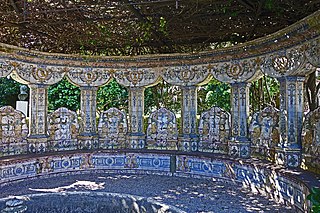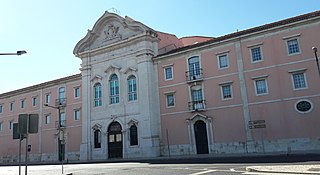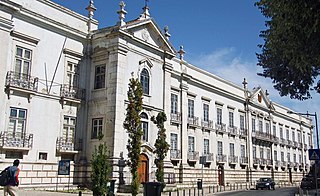
Demographic features of the population of Portugal include population density, ethnicity, education level, health of the populace, economic status, religious affiliations and other aspects of the population.

The municipality is the second-level administrative subdivision of Portugal, as defined by the 1976 Constitution.

The Lisbon Metropolitan Area is a metropolitan area in Portugal centered on Lisbon, the capital and largest city of the country. The metropolitan area, covering 17 cities in 18 municipalities, is the largest urban area in the country and the 10th largest in the European Union, with a population in 2015 of 2,812,678 in an area of 3,015.24 km².

The Porto Metropolitan Area is a metropolitan area in northern Portugal centered on the City of Porto, Portugal's second largest city. The metropolitan area, covering 17 municipalities, is the second largest urban area in the country and one of the largest in the European Union, with a population in 2021 of 1,737,395 in an area of 2,040.31 km².

Soure is a town and municipality of the Coimbra District, in Portugal. The population in 2011 was 19,245, in an area of 265.06 km². It includes a castle listed as a national monument.

Lisbon Region is one of the seven NUTS II designated regions of Portugal, which coincides with the NUTS III subregion Lisbon Metropolitan Area. The region covers an area of 3001.95 km2 and includes a population of 2,815,851 inhabitants according to the 2011 census, a density of 1039 inhabitants/km2.

Alvalade is a freguesia and typical quarter of Lisbon, the capital city of Portugal. Located in central Lisbon, Alvalade is south of Lumiar and Olivais, west of Marvila, east of São Domingos de Benfica, and north of Avenidas Novas and Areeiro. The population in 2021 was 33,309.

The Parque das Nações, colloquially known as Expo, is a freguesia and typical quarter of Lisbon, the capital city of Portugal. Located in eastern Lisbon, Parque das Nações is to the east of Olivais, northeast of Marvila, and directly south of Lisbon's border with Loures. The population in 2021 was 22,382.

Olivais is a freguesia and typical quarter of Lisbon, the capital city of Portugal. Located in eastern Lisbon, Olivais is west of Parque das Nações, north of Marvila and Alvalade, and east of Lumiar and Santa Clara. The population in 2021 was 32,179.
Afro-Portuguese(Afro portugueses or Lusoafricanos), African-Portuguese(Portugueses com ascendência africana), or Black Portuguese are Portuguese people with total or partial ancestry from any of the Sub-Saharan ethnic groups of Africa.

Lumiar is a freguesia and typical quarter of Lisbon, the capital city of Portugal. Located in northern Lisbon, Lumiar is east of Carnide, north of Alvalade, west of Olivais, and south of Santa Clara and partially of Lisbon's border with Odivelas. The population in 2021 was 46,334.

Beato is a freguesia and typical quarter of Lisbon, the capital city of Portugal. Located in eastern Lisbon, Beato is south of Marvila and Areeiro, and west of Penha de França. The population in 2021 was 12,183.

Carnide is a freguesia and typical quarter of Lisbon, the capital city of Portugal. Located in northern Lisbon, Carnide is north of São Domingos de Benfica and Benfica, east of Lumiar, and directly south of Lisbon's border with Odivelas. The population in 2021 was 18,028.

Marvila is a freguesia and typical quarter of Lisbon, the capital city of Portugal. Located in eastern Lisbon, Marvila is to the southwest of Parque das Nações north of Beato, and east of Alvalade. The population in 2021 was 35,479.

Penha de França is a freguesia and typical quarter of Lisbon, the capital city of Portugal. Located in the historic center of Lisbon, Penha de França is north of São Vicente, east of Arroios, south of Areeiro, and west of Beato. The population in 2021 was 28,475.
Avelar is a civil parish of the municipality of Ansião, Portugal. It was a vila during two occasions: for the first time from November 12, 1514 through December 31, 1836; and for the second time from June 21, 1995 to the present day.

Santa Clara is a freguesia and typical quarter of Lisbon, the capital city of Portugal. Located in northern Lisbon, Santa Clara is north of Lumiar, west of Olivais, and directly south of Lisbon's border with Odivelas and Loures. The population in 2021 was 23,645.

São Vicente is a freguesia and district of Lisbon, the capital of Portugal. Located in the historic center of Lisbon, São Vicente is to the east of Santa Maria Maior, south of Arroios, and west of Penha de França. São Vicente is home to numerous historic neighborhoods, including Alfama. The population in 2021 was 13,956, for a population density of 7,013.1 inhabitants per km2 on an area of 1.99 square kilometers

António Manuel Filipe Rocha Pimentel is a Portuguese academic and art historian currently the director of the Calouste Gulbenkian Museum in Lisbon, Portugal.

Local elections will be held in Portugal in late September or early October of 2025. The election consistes of three separate elections in the 308 Portuguese municipalities, the election for the Municipal Chambers, whose winner is automatically elected mayor, similar to first-past-the-post (FPTP), another election for the Municipal Assembly, as well an election for the lower-level Parish Assembly, whose winner is elected parish president. This last will be held separately in the more than 3,000 parishes around the country.












































